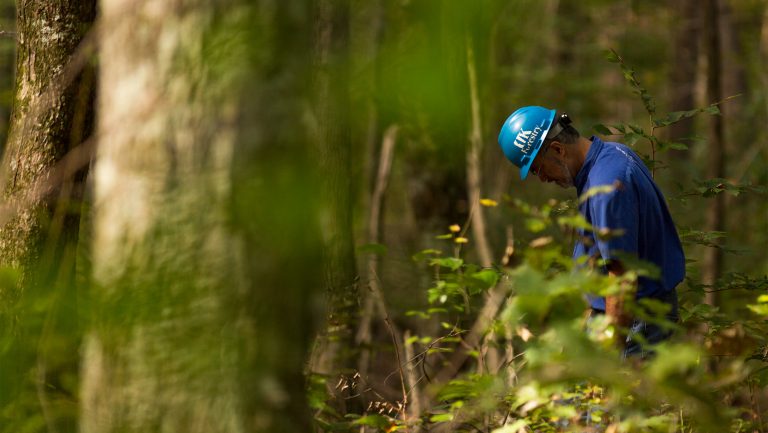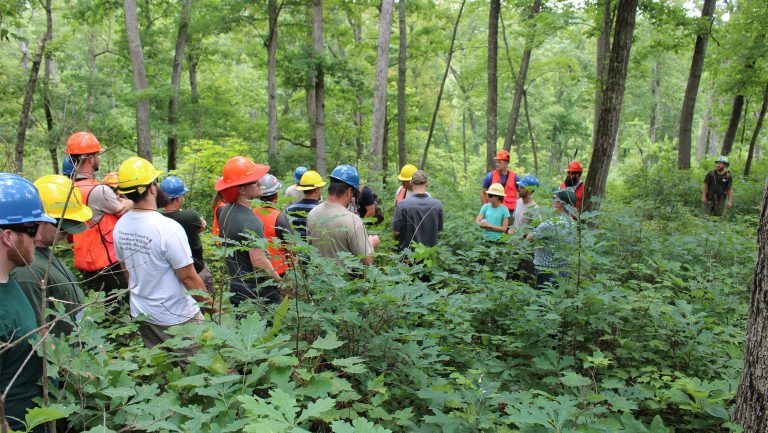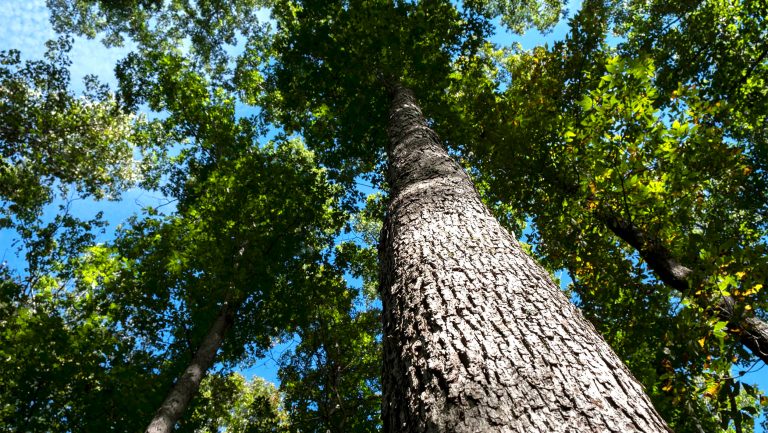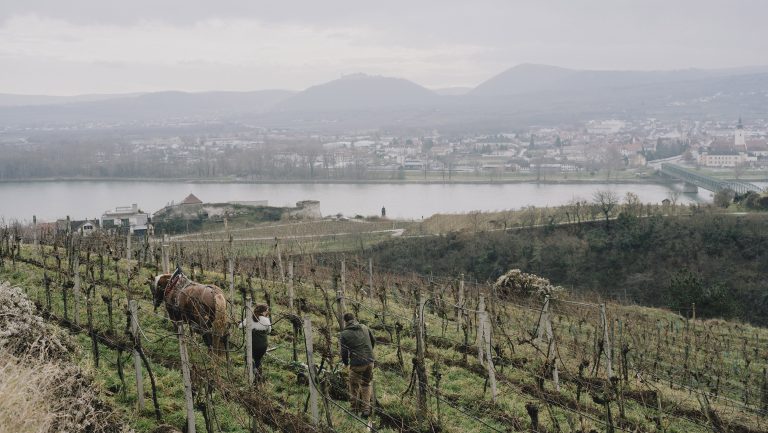Erica Tergeson has worked as a lobbyist on Capitol Hill for more than two decades. But the tools she previously used weren’t as congenial as they are now in her gig with the White Oak Initiative (WOI). “There’s no easier way to explain the issues to a Hill staffer, or Congressman, or Senator than having them taste some bourbon and then talk about why this is important,” she says.
Comprising a coalition of researchers, conservationists, foresters, policymakers, and big players from industries including cooperage and distilling, the WOI’s mission is to secure the future of the United States’ oak forests and a key species in them—the white oak. The tree from which bourbon barrels are made is in jeopardy. If oak forests are not properly managed, we could see an end to the species’ viability as a usable product within a generation. States need funding to support landowners’ care of their woods. Tergeson is lobbying for money for white oak renewal in the upcoming Farm Bill, the next appropriations bill, and the Trillion Trees Bill, which is aimed at climate sequestration—and she works with a bottle in hand.
Indeed, if you want to create a buzz around a sleeper issue like forestry management, invite Brown-Forman, Beam-Suntory, and Sazerac to the party. “There’s a different level of awareness and funding for the issue because these companies care about having white oak in the future,” says Tergeson. “Bourbon makes forestry cool.”

Don’t miss the latest drinks industry news and insights. Sign up for our award-winning newsletters and get insider intel, resources, and trends delivered to your inbox every week.
The WOI’s goal is to establish a healthy balance of mature and young white oaks on 100 million acres by 2070, so that the species is abundant enough for future batches of bourbon. They’re working towards this goal by doling out grants, sharing knowledge, and developing informational materials for forestry management across 17 states. It’s a unique illustration of the ways in which extractive industries like cooperage and distilling can manage their resources sustainably, and collaborate across industry lines, to the benefit of business, wildlife, and the climate.
The Importance of White Oak to the Beverage Industry
A hardwood species producing particularly tasty acorns, white oak (Quercus alba) ranges over 104 million acres of mixed oak and oak-hickory forest from Maine to Minnesota, Texas to the Florida Panhandle. “Deer, turkey, ruffed grouse, bears, squirrels—animals big enough to eat its acorn, do so,” says Jeff Stringer, the cofounder of WOI and the chair of the Department of Forestry and Natural Resources at the University of Kentucky. Endangered and at-risk species, including cerulean warblers and some forest-dwelling bats, live in the trees, which host over 100 species of moths and butterflies, as well.
It’s just as important to humans. With applications in furniture, cabinetry, flooring, and barrel making, white oak has among the highest economic value of any hardwood where it grows. In Kentucky alone, the WOI estimates that white oak makes an $8 billion annual impact, three-quarters of which is generated by the distilling industry.
In fact, without white oak, there is no bourbon. The tree is adept at producing tylosis, balloon-like cellular growths that make its wood liquid-tight for barrels. Its lignins, chemicals that give it rigidity, bring bourbon its vanilla, caramel, and other flavors. Charred white oak casks lend bourbon its amber hue.

“Master distillers are always talking about contributions the barrel makes to bourbon, providing all the color and over 60 percent of flavor,” says Greg Roshkowski, the VP general manager at Brown-Forman’s BF Cooperage and a WOI Steering Committee member. Though, by law, bourbon can only be produced in new barrels, there’s a robust market for used white oak casks, which “get longevity through Scotch, tequila, rum, Tabasco sauce, coffee, wine, and other liquids that use them for 50 to 60 years afterwards,” says Roshkowski.
White oak fetches a good price thanks to the quality of its wood. “The average industry rate is $2.25 a board foot,” notes Garrett Nowell, the director of log procurement and sales at the world’s largest barrel maker, Missouri’s Independent Stave Company. “Red oak is 60 cents a foot.” Independent Stave buys trees across 24 states. With small, family forests hosting more than 53 percent of white oaks in the U.S., the high price of its timber is a potential boon to landowners who manage it wisely. “They can get $2,250 an acre if they have a nice stand,” says Nowell.
Raising White Oaks for Cooperage
While other industries use other parts of white oak, Nowell needs cooperage-ready wood—minimal knots, no fire scars or rot—in logs of 12- to 14-feet long with a diameter of 13 to 14 inches at their smaller end. “On average, we get a couple barrels out of one tree,” says Nowell. “White oak comprises about 17 percent of forest in the eastern U.S. Cooperage quality is 11 percent of that 17 percent. So about two to five percent of wood out there can turn into barrels.”
Raising stave-quality wood takes decades. In the normal course of production, mature trees that have issues are cut to remove half or more of the forest allowing light for the next generation, and leaving higher quality trees behind for the next seed source. “Then, in the next 20 to 30 years, you come back to remove that stand you left behind, and it’s a cycle we keep doing,” says Nowell.
Unlike monocropped pine plantations, managing white oak is good for biodiversity. “You might walk onto a 30-acre property and find 40 different species of trees,” says David Apsley, the natural resource specialist with the Ohio State University Extension. “If we do management for white oak, it helps all the oaks and hickories.”
And the longevity of white oak and its wood has benefits for carbon sequestration. The species is relatively climate resilient, withstanding heat and drought conditions better than other trees. “It will be 80 to 100 years old before it becomes a high-value forest product, and a high percentage goes into long-lived wood products,” says Stringer. “The system maintains a lot of carbon over time.”
In the best-case scenario, there are plenty of seedlings to grow up and perpetuate the cycle. But that’s not what’s going on in America’s oak forests. Right now, there are more than enough mature white oaks. “But we have known since the early 1980s that we were having a regeneration problem,” says Stringer. “We have oak-dominated forests that have very few or very small seedlings and saplings. The acorns are hitting the ground, seedlings are initiated but never grow in size, so we never have development of large seedlings and saplings that will perpetuate themselves. We don’t have a progression of recruitment.” That progression won’t happen unless humans intervene.
The Problem of Forest Management
Oak forests in the U.S. are a product of centuries of human intervention. Native Americans conducted prescribed burns—managed fires that cleared forest for game-luring grasslands, berry bushes, and nut-producing trees like oak. “After European settlement, we cleared land for industry, like iron ore production, which facilitated oaks flourishing,” explains Cotton Randall, the cooperative forest management administrator for the Ohio Division of Forestry. The reduction in forest cover suppressed shade-loving species like beech and maple, letting in the dappled sunlight oak seedlings need to grow.

But the intensity of land use a century or two ago tipped the balance too far. “Back then, we did wide-scale burning on purpose or accident. We abused the system with practices we don’t think [are] appropriate now,” says Stringer. That realization led to policies that introduced decades of fire suppression, such that shade-loving trees have enveloped the undergrowth again. Add in pests and invasive plants encouraged by climate change, and baby oaks don’t stand a chance.
But controlling invasive species and pests, and cutting to provide light to the understory, takes commitment and resources many forest owners don’t have. “Missouri’s forest cover is 15 million acres, and 12 million acres are privately owned. Only 10 percent of that is being actively tended to,” notes Missouri State Forestry specialist Hank Stelzer. “Landowners have the attitude, ‘If it’s green, it’s good.’ So the forest is like an unweeded garden, and we know what happens when you neglect a garden. You don’t get large tomatoes; you get insects and disease. We see the same thing in woodlands. We don’t get the quality white oaks or those that can sustain climate change.”
How is a forester like him going to get his state’s “complex tapestry” of forest owners to nurture the next generation of white oak trees? That’s where the WOI comes in.
The Promise of the White Oak Initiative
“If we allow things to go on like they are, oaks won’t go extinct. They just will occur in a lot less abundance,” says Stringer. “It’s an issue because we have come to expect oak to be present for industrial uses: bourbon, wine, whatever.”
Stringer knows what’s needed: widespread application of a set of proven silviculture practices, including midstory and understory tree removal, targeted use of herbicides, prescribed burns, and other forestry regimens that will allow white oak saplings to establish themselves on a site years before a timber harvest occurs there. “But I can’t do this by myself being a researcher sitting in an ivory tower in Lexington,” he says.
In 2017, the owners of Brown-Forman, Stringer, and Tom Martin, then-president of the American Forest Foundation, launched the WOI, aided by the DendriFund, a non-profit started by the Brown family. The Initiative “brings together groups with seemingly diverse interests, yet the importance of white oak serves as our common thread,” says Elizabeth Wise, the senior vice president for government affairs at Sazerac and an executive committee member of the WOI’s Steering Committee.
Its first project was Restoring Sustainability for White Oak and Upland Oak Communities, an assessment and conservation plan that organizes the advocacy around scientific data, forestry best practices, and targeted recommendations for each sub-region in which white oak grows. “The plan speaks volumes about the status of the species, the significance it has to this country, and what we can do now to sustain its vitality,” says Wise. “Thus far, I think we have elevated people’s thinking about the species.”
After the WOI brought the issue to the U.S. House of Representatives in 2022, in a tangible success, a dozen Republicans and Democrats were inspired to form the White Oak Caucus. Cofounder Andy Barr, a congressman from Kentucky, said in a statement over email, “The White Oak Caucus is committed to working with industry experts and advocates to explore all options to maintain sufficient supply of white oak trees for generations to come.”
Tergeson remembers a Blanton’s barrel tasting with the White Oak Caucus: “The representatives got to agree on the barrel they liked and had a special label put on that bourbon,” she says. “It’s a bipartisan issue, for once.” Her efforts have involved creating an internal working group for white oak sustainability at the United States Department of Agriculture and pushing for a federal program that would incentivize private landowners to hold off on timber removal until white oak saplings are established in their woods.

At the state level, “the WOI makes it easier to broaden our partnerships, reach more stakeholders, and get that message through their networks that will influence behavior on the ground,” says Randall. “There are a lot more landowners than forestry professionals, so anything we can do to supplement our efforts and create efficiencies can help us reach landowners.” The group discussions have helped him solve problems and WOI materials have given him “well-thought out talking points.” WOI grants have paid for demonstration sites on public land that show private forest owners best practices.
“So many forestry practices and initiatives are fragmented because they’re state by state,” says Roshkowski. “Pulling the group together, it clicked.” In Missouri, a $700,000 matching grant from WOI member Independent Stave allowed Stelzer to hire another forester and to garner funds and cooperation from local distilleries like Switchgrass Spirits and Copper Mule and Missouri wineries-owned Hoffmann Family of Companies. “Those venues are how we are going to raise awareness [amongst] landowners,” he says. “They’re sitting at a winery or touring a distillery, and we can tell them, ‘If you really like this, we need to start managing our forests now, because in 80 years we won’t have white oak to the level of growth we need for the wine and spirits industry.’”
As Roshkowski points out, spirits brands have the megaphones to amplify the WOI’s message. “With the bourbon industry garnering headlines as trendy, it has momentum, so it’s a story that people listen to,” he says. So the congressional bourbon tastings will go on. “The best way to get people’s interest is to have some sort of event. If senators and congressmen can’t make it, all their pages and representatives are happy to partake, and getting in front of those people is important, as they do the legwork.”
All of that networking is ultimately geared toward helping forest owners care for an invaluable resource that grows on their land. But for proactive landowners who take the WOI’s message to heart, the intoxication comes from an increased appreciation for white oak. Joe Davis, a family forest owner who was Missouri’s 2021 Tree Farmer of the Year, worked with the state to do all the right things to support white oak saplings before cutting timber. “We can walk on our 40 acres and see all these white oak saplings that are regenerating because of sunlight after that harvest,” he says, adding, “I’m not a huge drinker, but I drink a bit of bourbon. If it comes in a cool, white oak barrel, then I’m definitely interested.”

Dispatch
Sign up for our award-winning newsletter
Don’t miss the latest drinks industry news and insights—delivered to your inbox every week.
Betsy Andrews is an award-winning journalist and poet. Her latest book is Crowded. Her writing can be found at betsyandrews.contently.com.







